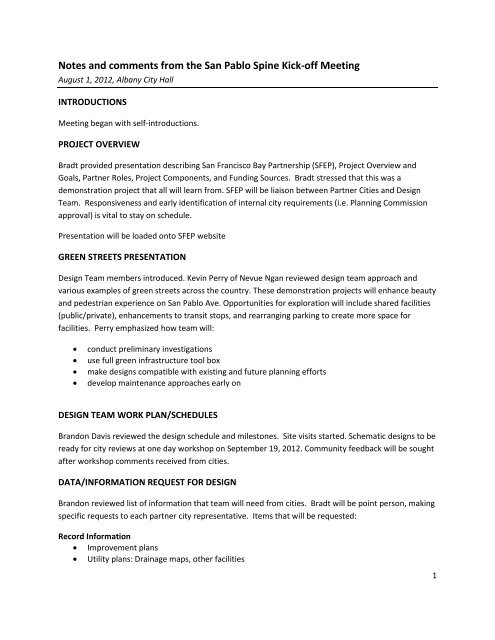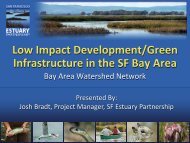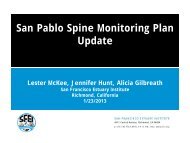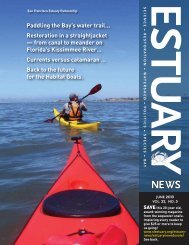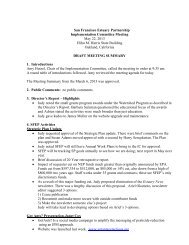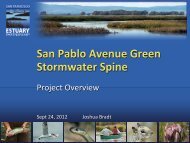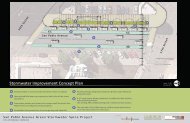SPASS Kick Off Meeting Notes - San Francisco Estuary Partnership
SPASS Kick Off Meeting Notes - San Francisco Estuary Partnership
SPASS Kick Off Meeting Notes - San Francisco Estuary Partnership
Create successful ePaper yourself
Turn your PDF publications into a flip-book with our unique Google optimized e-Paper software.
<strong>Notes</strong> and comments from the <strong>San</strong> Pablo Spine <strong>Kick</strong>-off <strong>Meeting</strong>August 1, 2012, Albany City HallINTRODUCTIONS<strong>Meeting</strong> began with self-introductions.PROJECT OVERVIEWBradt provided presentation describing <strong>San</strong> <strong>Francisco</strong> Bay <strong>Partnership</strong> (SFEP), Project Overview andGoals, Partner Roles, Project Components, and Funding Sources. Bradt stressed that this was ademonstration project that all will learn from. SFEP will be liaison between Partner Cities and DesignTeam. Responsiveness and early identification of internal city requirements (i.e. Planning Commissionapproval) is vital to stay on schedule.Presentation will be loaded onto SFEP websiteGREEN STREETS PRESENTATIONDesign Team members introduced. Kevin Perry of Nevue Ngan reviewed design team approach andvarious examples of green streets across the country. These demonstration projects will enhance beautyand pedestrian experience on <strong>San</strong> Pablo Ave. Opportunities for exploration will include shared facilities(public/private), enhancements to transit stops, and rearranging parking to create more space forfacilities. Perry emphasized how team will:• conduct preliminary investigations• use full green infrastructure tool box• make designs compatible with existing and future planning efforts• develop maintenance approaches early onDESIGN TEAM WORK PLAN/SCHEDULESBrandon Davis reviewed the design schedule and milestones. Site visits started. Schematic designs to beready for city reviews at one day workshop on September 19, 2012. Community feedback will be soughtafter workshop comments received from cities.DATA/INFORMATION REQUEST FOR DESIGNBrandon reviewed list of information that team will need from cities. Bradt will be point person, makingspecific requests to each partner city representative. Items that will be requested:Record Information• Improvement plans• Utility plans: Drainage maps, other facilities1
• Studies/Reports: Geotechnical, hydrology, hydraulics• MappingDesign Standards• Ordinance• Standard Details• Specifications• Bay Friendly LandscapingOPEN DISCUSSION TOPICS & ISSUES RAISEDFollowing the presentations, the remaining meeting time focused on partners asking questions,sharing information, making recommendations, and voicing concerns. The discussions are capturedby topic:CITY AGREEMENTSBradt indicated that draft agreements have been prepared for City review. These will be providedshortly to allow time for City Manager/City Attorney review. No direct monetary contributions areexpected from the participating cites. The primary functions of agreement:1) Allow SFEP and its agents access to the site throughout the term of the project2) Affirm that the cities agree to take over long-term maintenance and reporting obligations3) Ensure city partners participate/facilitate processDraft Contracts will be distributed as soon as possible. Hope to have executed in September. W Citypartners should still participate fully in design process while contract agreements are negotiated.Concerning easement/accessDiscussion indicated that cities have differing approaches to ownership/management of the right-ofway.For example, in Oakland, property ownership extends through the sidewalk to the back of curb.City has easement granting public use. Thus improvements in Oakland may need to be placed onproperty-owners’ deed.• Ken Moy, ABAG Legal Counsel, will redraft easement/access portion of agreement to accountfor this variance.MAINTENANCE• The maintenance staff may not be used to duties of maintaining green infrastructure• Plants collect a lot of trash (means facility is working). Sites may need weekly trash collection.The green streets trash issue may be an educational opportunity2
• According to Water Board, facilities may be considered full trash capture if there is trashcollection plan to remove stranded trash before remobilization.Maintenance Period• The longest possible maintenance period allowable under the grants is preferable.• The needs of landscaping change from the initial to following years. Typical post-constructionmaintenance contracts are for 3-5 years, not 2• Suggestion made to make the construction company responsible for one year of postconstructionmaintenance, then have plant establishment period/contractor.Maintenance Plans• Provide cities with estimates of maintenance costs (important for City Council and Commissions)• Consider having two maintenance plans:o First plan created by Design Team based on treatment facility typeo Second plan by plant establishment contractor revises the first based on lessonslearned during establishment periodDESIGN APPROACH & PROCESS• The design specifications will be based on Caltrans 2010 specifications. Cities will need toprovide additional specifications as necessary for full bid package.• Projects may be scaled depending on construction costs.• Design team will look at shared facilities options with Private sector (i.e. capture parking lotrunoff behind sidewalks)• Design so that the stormwater does not undermine or compromise existing street uses orutilities. Avoidance will be preferred approach.• Preliminary conversation with utilities may be needed• To ensure best possible start for vegetation, may want to separate bid package:ooHardscape contractorPlanting/landscaping specialistWorkshop <strong>Meeting</strong> (September 19)• All day schedule, with each city having a one hour slot to discuss schematic design and sitespecific issues with design team.• Suggested that meeting be held in two locations – am in Oakland, pm in El Cerrito.• In addition to their own, city partners may attend another city’s review session.3
City Approval Processes (beyond technical design review)• There is enough permanent greening in the project that may require a backing by the planningcommission.o Emeryville and El Cerrito may need Planning Commission backingo Material needed may just need schematics and CEQA findings• Cities need to confirm if the planning commission (or other) is needed for designreview/approvalBay-friendly Landscaping• Bay-friendly landscaping may be harder to maintain,• Landscaping may look like brown sticks during dry season• There are points earned through design and maintenance• Tools and training will be necessary for maintenance around bay-friendly landscapingOUTREACH<strong>Kick</strong>-off meeting• Make presentation available on SFEP website for public works department and committees• Include links to green streets video podcasts:o “we cut the curbs to claim the rain”o “slow it, sink it, spread it”Public outreach process• SFEP to lead neighborhood outreach process. This will include some preliminary outreach (door–knocking) to identify community priorities prior to September 19 workshop.• Formal meeting s would occur after Design Team incorporates City-recommended changes toschematic designs• Planning Commission meetings may be used satisfy outreach element in certain cities• Schedule of meetings needs to be solidified early to ensure adequate attendanceMONITORING• Monitoring program currentlyunder development with <strong>San</strong> <strong>Francisco</strong> <strong>Estuary</strong> Institute andReNUWit Program.4


